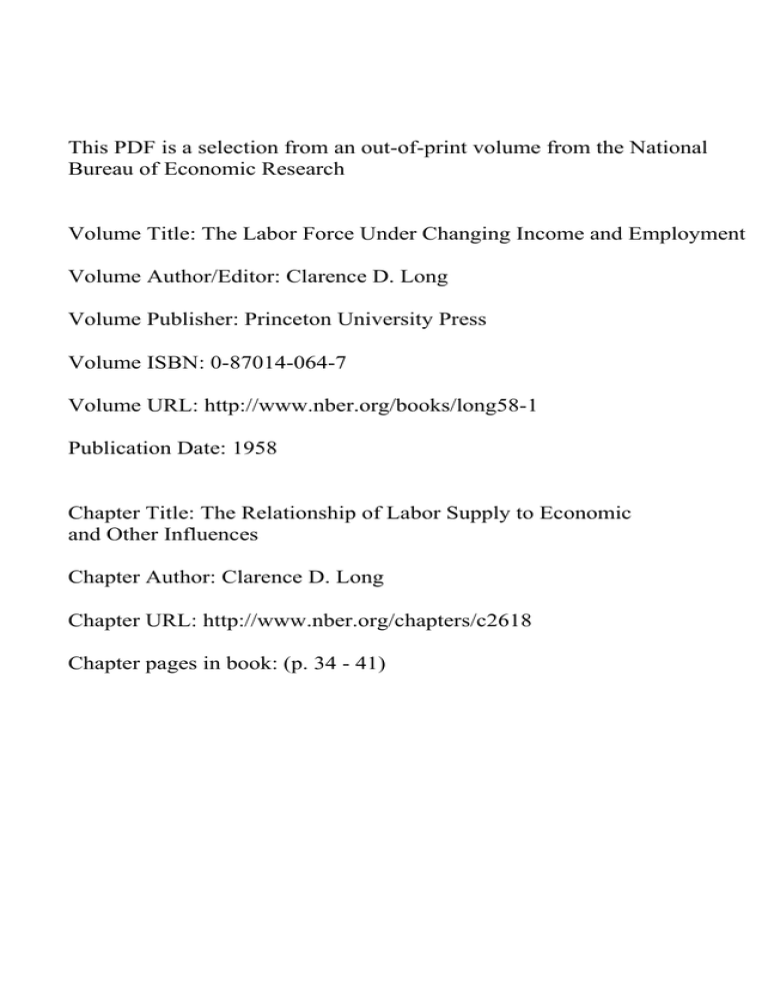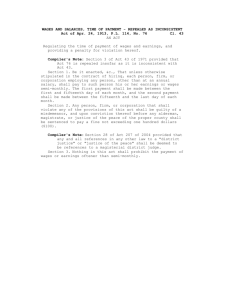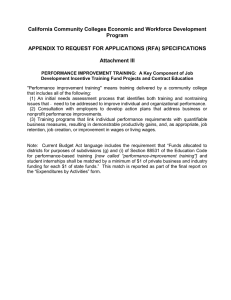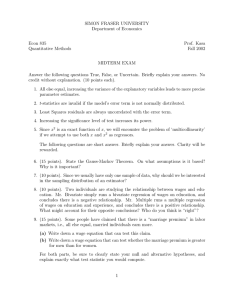THE RELATIONSHIP OF LABOR SUPPLY TO ECONOMIC AND
advertisement

This PDF is a selection from an out-of-print volume from the National Bureau of Economic Research Volume Title: The Labor Force Under Changing Income and Employment Volume Author/Editor: Clarence D. Long Volume Publisher: Princeton University Press Volume ISBN: 0-87014-064-7 Volume URL: http://www.nber.org/books/long58-1 Publication Date: 1958 Chapter Title: The Relationship of Labor Supply to Economic and Other Influences Chapter Author: Clarence D. Long Chapter URL: http://www.nber.org/chapters/c2618 Chapter pages in book: (p. 34 - 41) CHAPTER 2 THE RELATIONSHIP OF LABOR SUPPLY TO ECONOMIC AND OTHER INFLUENCES "Everyone. but an idiot knows that the lower classes must be kept poor or they will never be industrious." ARTHUR YOUNG Some Theories of Labor Behavior EACH person may have a different reason or combination of reasons for working. Everyone may go through stages in his life when new influences appear and others fade away. These motivations could, not depend merely on the personality of the individual. They are likely to spring from many external factors—differing among persons or during the life of a given person—which not only influence his motivation to work (given his personality) but also alter his personality. The many reasons for working and the factors that nourish them are the product of social, cultural, or spiritual forces independent of—even at war with—economic motivations. Nevertheless, there are enough obvious roots in economic soil to warrant inquiring whether economic forces, such as employment opportunities or income, play an important role in determining the supply of A specffic question that has always intrigued economists is: Does an increase in wages cause the labor supply to expand or to shrink? Many thinkers have concluded that once workers have satisfied their pressing needs for food, clothing, and shelter, they will., be eager for surcease from honest toil. "This view [the view that iow wages mean large labor supply]," said Maurice Dobb, "seems to have been exclusively held by earlier centuries to the neglect of other considerations." 1 The belief that people will work less as they become more prosperous has. not been the sole property of earlier centuries. For example, W. Stanley Jevons held that "English labourers enjoying little more than the necessaries of life, will work harder the less they produce; or will work less hard as the produce increases. . '. The richer a man becomes, the less does he devote himself to business." 2 Frank Knight has suggested that one of the goods purchased with increased earnings is leisure.3 Even J. A. Hobson, never one to cast his reflections in the classical mold, has conceded that, "Though workers . . will hardly . . 'Maurice H. Dobb, Wages (Cambridge Economic Handbook), London, Cambridge University Press, 1948, p. 59. 2 Theory of Political Economy, London, Macmillan, 4th ed., 1911, pp. 180—181. Risk, Uncertainty, and Profit, Houghton Muffin, 1921, p. 117. 34, INFLUENCES ON LABOR SUPPLY ever claim a shorter working day if they know it to involve an actual fall of wages, . . they will sometimes risk, the fall and more often they will forego a portion of a contemplated rise of wages, so as to get a shorter day." And the forward-looking Sir Sydney Chapman predicted, decade after the turn of the century, that "the attempt would almost certainly be to buy more leisure with higher wages, all the more so since each hour of leisure is enriched by possession." He agreed with Schmoller that "the more complex the social organization, the more time its members must devote to family and recreation, education and . general affairs." Most of the foregoing conclusions have been based more or less explicitly on the notion that people work less as they become more prosperous because the more goods a person. commands as a result of his higher income, the less he is inclined to value any additional amounts and the less work he is inclined to do to acquire them. These conclusions have not, however, as Lionel Robbins made clear, been founded on very precise analysis of how people do, in practice, value income in terms of effort. Increased affluence would, other things being equal, be accompanied by reduced labor supply per dollar of income, but could• be perfectly compatible with either an increase or a decrease in the total labor supply. Since no two individuals would necessarily react in the same way, how can one know what the average person will do? Solely by measuring the differences in labor supply under varying wages. The Relation of Labor Sup to Economic and Other Influences The aggregate quantity of labor supplied to the market by the inhabitants of a nation or locality, as reflected by the labor force and, to some extent, by hours is the subject of this investigation. Determination of how much of the supply goes to individual firms is beyond the scope of the study, since migration and industrial and occupational mobility are even more complicated matters than the labor force. Also outside its range is group control of labor supply in the form of collective bargaining or other devices. It is impossible to measure the effects of such activity because of the subtle and complicated combinations of political and economic factors, the variety of union constitutions and practices, and the shortage of statistics. Indeed, to the extent that unions behave as monopolists and therefore try to maximize the income of their mem- bers, they must take the demand for labor into consideration in de- "Hours of Labour,"• Economic Journal, September 1909, pp. 357—358. "On the Elasticity of Demand for Income in Terms of Effort," Economi.ca, June 1930, pp. 123—129. 35 INFLUENCES ON LABOR SUPPLY termining the supply of labor; thus there can be no such thing as a supply independent of demand. Group control will no doubt be affected by some of the considerations that govern individuals acting independently; during a strike the union will not hold out as long, or for as favorable a settlement, if its members are anxious to get back to their regular earnings. But, in the main, the wages and other supplementary benefits it aims for will depend on what it believes to be the demand for labor.6 We investigate the aggregate behavior of individuals in entering and leaving the labor force, or in working a long or short week, on the assumption that these decisions would not appreciably affect the wage of the individual or his family, and, as a corollary, that each individual acts quite apart from others insofar as any intention of manipulating. wages is concerned. It is not implied, however, that the individual makes up his mind to enter or to leave the labor force with complete independence. As we noticed earlier, he is influenced in a thousand ways: by the number of other adults in his family who are already in the labor force or ready to join it; by community attitudes that "woman's place is in the home" and the man should provide; by his neighbor's standard of living; and by an inclination to conform with fellow members in his union, lodge, and country club. He is bound by laws which keep his children out of the labor force and in school until a certain age, which set maximum hours or minimum wages and may, in cases of borderline make it impossible for his wife (or perhaps his children, or himself) to get a job. And he is affected by rules laid down by employers in the interest of efficiency and humanity. They may prevent his wife, from working half time and, since she must be home when the children are not in school, may thus prevent her from working at all; they may force him to retire at 60 or 65 although he is willing and able to continue working. Group influences on the individual are considered wherever possible, but this does not prohibit dealing with the relation between the labor force, on the one hand, and wages or income as an independent variable on the other. With few exceptions, the labor force is expressed in this inquiry as a percentage of the population, and the forces that determine the size of the population are ignored. Nevertheless, the percentage of population in the labor force will vary with the characteristics of the population and these characteristics must carefully be taken into account. It will be higher if the inhabitants are predominantly men, if they are healthy, intelligent, well educated, adaptable, emotionally stable and °F. H. Knight, "Supply," in Encyclopedia of the Social Sciences, Vol. XIV, p. 473; J. T. Dunlop, Wage Determination under Trade Unions, Macmillan, 1944, pp. 31—32. 36 INFLUENCES ON LABOR SUPPLY therefore to a high degree employable, if they live in families of one or two people, or if many of them are Negroes or city dwellers. It will be lower if most women are married and have young children to care for. In Western nations, it will be lower if most people live on isolated farms or in small villages, where the only jobs are frequently too distant for easy commuting. Not to be overlooked as an influence on the peróentage of population in the labor force is the nature of industry. Business or labor organizations help to determine in what occupations or industries workers are concentrated. More women may be in the labor force if the full-time week is very short and flexible, or if there is an abundance of clerical, service, and light bench jobs. Old or disabled men presumably have a better chance of staying on if the pace of industry is not too fast. Young people have more opportunities to get jobs after school or in summer if there are no rigid union rules against child labor or apprentices. Even climate may have something to do with willingness and ability • • to work, though present-day geographers point out the weakness of the evidence on this topic. Finally, if wages or income influence the propensity to work they need not do so in any simple way. Although the wage offered may be the most obvious factor influencing a man's decision to work, he may • also take into consideration his nonlabor income, such as dividends, interest, rent saved from living in his own home or other property income, and the incomes of other members of his family. In theory, his decision can be affected by the amount and type of taxes to which he is subject. More women might enter the labor force if, in computing income tax, they could deduct the cost of maids, baby sitters, and nursery schools. Some well-to-do persons might postpone their retirement if increased income taxes reduced their ability to save—or, conversely, if the income tax were made less steeply progressive, permitting them to keep a larger share of what they earn. We need to know whether these theoretical effects of taxation on labor force participation have been realized in any noteworthy way in practice. The reaction of labor supply to a given wage may, moreover, be affected by the way income is distributed; for people not only work, but spend, competitively. A family with a $5,000 annual income may have very different labor force propensities depending on whether its neighbors' incomes average $7,500 or $2,500. Also possibly significant —and so far entirely overlooked—is the way income is distributed among members of the same family. For example, wives, to a considerable extent, receive fixed incomes and may conceivably be pressed into the labor force in increasing numbers during inflation by rising costs of food, clothing, and cosmetics. 37 INFLUENCES ON LABOR SUPPLY Also to be considered is the way in which incomes are received— whether the wage or salary is fixed per hour, week, or year; whether higher than proportional pay is received for overtime; whether the worker is on a commission or a piece rate; whether the income is regular or fluctuates so that a person must earn enough in good times to tide him over slack periods; and, finally, whether taxes are withheld each month, paid at the end of the year, or taken as- excise levies on commodity purchases. Closely related to income is wealth. Do a man's assets exceed his liabilities, can he draw on them readily, and how do they compare with his standard of living? Also related are claims on social security by an older man who ponders retirement; claims on unemployment insurance by a young wife who pretends to be seeking employment when, her actual plan is to have a baby; claims on military allowances by a soldier's wife, who may discover in some countries that working does not yield enough extra to justify giving up the government subsidy; claims for educational allowances by a discharged veteran who is considering college or trade school. Akin to all these is credit: the ability to borrow from relatives, or to charge the expense of necessities during a brief period of unemployment or sickness, may make it unnecessary to withdraw children from school in order to help with the family support.7 To assess the impact of these various factors is not easy nor is it always possible. Data are often lacking, or are not easily related to labor force behavior—as in the case of credit, income distribution, com- munity attitudes, health, intelligence, and emotional stability. Many of the forces are closely intercorrelated: high birth rates and heavy responsibilities for child care, which hinder women from entering the labor force, are often associated with low incomes, which may propel women into it. Participation among Negroes tends to be high; but is this due to their comparative poverty or to their cultural characteristics? Ideally, each factor should be examined separately, with the others held constant, as to its relation to the size of the labor force for different areas and groups, and over time. The factors should even be analyzed in various combinations, since, in economics as in chemistry, elements may act quite differently in combination than they do individually. But limitations of data make it necessary to settle for much less. Nevertheless, the data drawn upon are unusually rich and varied. Hicks suggests that the behavior of the poor may differ from that of the rich. A reduction in income may oblige the former to draw, at least for short periods, upon their leisure, i.e. to do more work, whereas the latter could avoid this by drawing upon their savings. However, the worker could for very short periods use credit as the equivalent of savings. 38 INFLUENCES ON LABOR SUPPLY Surely more money has been spent during the last half century in gathering statistics on population and the labor force than on any other major type of general-purpose statistics. These materials enable us to make a separate examination of labor force by age, sex, color, nativ- ity, military status, child-care responsibility, rural or urban loca- tion, density of rural population or size of city, average income of adult city worker, income group, school attendance, education completed, employment status of wife by income or employment status of husband, and working hours. Particularly valuable are the cross classifi- cations of the last two censuses, which enable us to answer hitherto puzzling questions, such as whether the participation of women is governed mainly by income or by opportunities of employment. Studies over time are no longer confined to the decennial censuses, which formerly left us quite in the dark as to what was happening between census years. Since 1940 a survey has been conducted for one week in each month by interviews with a sample of the nation's households. The sample results are blown up into national estimates of the labor force, employment, and unemployment, with many of the same breakdowns as in the decennial census. In addition, the monthly surveys provide information on characteristics not available m the ten-year enumeration, such as labor force turnover, availability of employed and unemployed for full-time or part-time work, and reasons for not working. These materials allow us to single out important relationships with fair precision. Where they are lacking in detail, other things may some- times be made equal by "standardization." Such devices always beg some questions. The problems raised by standardization are summarized in Chapter 3, but they cannot be solved to complete satisfaction. Indeed, a complete solution can never be obtained, even in theory, to the problem of "other things equal." For man's reactions are affected by his experience—even by the order of his experience: his decision to accept or turn down a certain job may (other things equal) depend upon whether he was once poor and is now well off, or was once well off and is now poor. If such sequences of experience are significant, as we believe they are, then the patterns of labor supply which we fit to cross-sectional data in this study are open to serious question. This is perhaps one of the reasons why the relation between the labor force and income over a period of time differs so markedly from the relation at a given moment of time. Some Previous Empirical Findings Observers alert for empirical evidence on the behavior of labor supply in response to changes in wages and incomes have not been lacking. 39 INFLUENCES ON LABOR SUPPLY As early as the decade after the Napoleonic Wars, Sir Edward West, in his Price of Corn and Wages of Labour, advanced the evidence of "witnesses before Committees of both Houses that the labourer in a scarce year, when his wage will furnish him with a much less than the usual quantity of food, will, in order to attain his usual supply of necessaries, be willing to do much more work than usual, even at a reduced rate of wages." 8 Very recently, P. J. D. Wiles has marshaled quantitative evidence and the testimony of travelers to support his conclusion that the "will to work" of the British has declined as compared with earlier periods and with other nations, and has ascribed the decline in part to progress.9 The first to measure labor supply systematically, how- ever, was Paul Douglas in his great classic, The Theory of Wages. Douglas, taking each of 38 large American cities as a separate observation, paired two sets of data: earnings of factory hands in 1919, and proportions of population in the labor force in January 1920. Later, in an article with Erika Schoenberg, he did the same for 1929—1930.'° His two investigations agreed closely in the following conclusions: 1. That there was at a moment of time a significant association among cities between the level of earnings and the rate of labor force participation. 2. That the labor force was smaller by approximately six workers per 1,000 population aged 14 and older (standardized for age and sex) wherever annual earnings of equivalent adult-male factory employees were higher by $100. 3. That the labor force tended, in relative terms, to be smaller by about % per cent (population remaining constant) wherever annual earnings were higher by 1 per cent. 4. That the tendency for a smaller labor force to be associated with higher adult-male earnings extended, with wide variations, to boys and girls, to females above school age, and to older men, but not to men 20—59. These conclusions, though interesting and important, represent 'only the beginning of an empirical investigation into the behavior of the labor force under changing income and employment. This is no reflection on the work of Professor Douglas, who dealt remarkably well with this complex matter within one chapter of a monumental treatise. But many and far-reaching questions remain. It is merely hinting at them to London, John Hatchard, 1828, p. 75. (I am grateful to George J. Stigler for this citation.) ° "Notes on the Efficiency of Labour," Oxford Economic Papers, Oxford, June 1951, pp. 158—174. 10 Paul H. Douglas, The Theory of Wages, Macmillan, 1934, Chapter XI; Erika H. Schoenberg and Paul H. Douglas, "Studies in the Supply Curve of Labor," Journal of Political Economy, February 1937, pp. 45—79. 40 INFLUENCES ON LABOR SUPPLY ask if the tendency obtains in rural areas, throughout states and nations, among richer and poorer persons in the same place at the same time, and for expanding incomes over long and short periods of time. Such questions, and the many others posed in subsequent chapters, can be resolved only through extensive further research. Before pursuing them, let us examine what is meant by labor supply and labor force, what are the various influences to which they may respond, and how reliable are the statistics upon which knowledge of their behavior must rely. 41






